![]()
![]()
![]()
Use LEFT and RIGHT arrow keys to navigate between flashcards;
Use UP and DOWN arrow keys to flip the card;
H to show hint;
A reads text to speech;
96 Cards in this Set
- Front
- Back
|
Diagram of lipid pathways and where drugs act at:
|
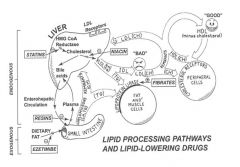
|
|
|
Which Apoprotein is the one that takes LDL back to the liver?
|
ApoB
|
|
|
If a patient is deficient in lipoprotein lipase what will be elevated?
|
Triglycerides
|
|
|
Treatment goals for lipid therapy:
|
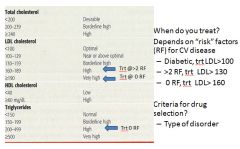
|
|
|
Common Lipid Disorders:
|

|
|
|
What do the statins do?
|
Inhibit HmgCoA, the enzyme and rate limiting step responsible for endogenous production of cholesterol
|
|
|
Statins:
|
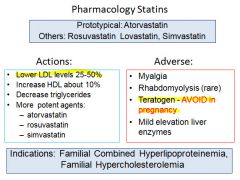
|
|
|
How do resins work?
|
By binding to bile acids and preventing recycling
|
|
|
Resins:
|
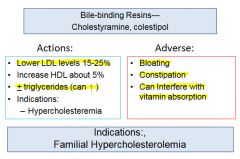
|
|
|
What does Ezetimibe do?
|
Decreases dietary absorption of cholesterol; Inhibits intestinal sterol transporter
|
|
|
Ezetimibe:
|
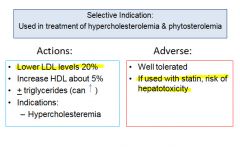
|
|
|
How does niacin work?
|
- Reduces hormone sensitive lipase activity
- Decreases free fatty acids & triglycerides - Reduces catabolism of HDL |
|
|
Niacin:
|

Can also increase blood glucose levels and worsen insulin resistance in type II diabetics!
|
|
|
How do fibrates work?
|
- Activator of peroxisome proliferator activating receptor- a
- Increases synthesis of adipose lipoprotein lipase VLDL & triglyceride breakdown, fatty acid oxidation in liver - Increase ApoA = increases HDL |
|
|
Fibrates:
|
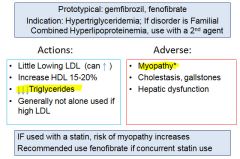
|
|
|
Chart of lipid lowering drug effectiveness:
|
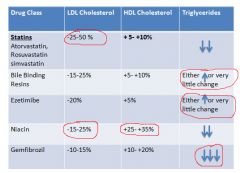
Niacin =greatest increase HDL
Statins=greatest decrease in LDL Most favorable increase HDL:LDL ratio = niacin Bile binders & ezetimibe can increase triglycerides |
|
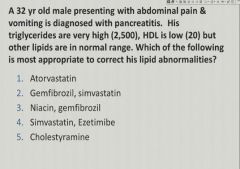
|
Niacin and gemfibrozil
|
|
|
Lipid treatment exercise:
|
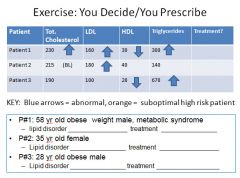
Answers:
P1: Familial Combined Hyperlipoproteinemia (metabolic syndrome) - ideal = statin, niacin, fenofibrate P2: Familial Hypercholesterolemia –heterozygous (likely cause : LDL receptor or Apo B) = start on statin (HDL good) P3: Familial Hypertriglyceridemia (likely cause: disorder ApoA-V)= gemfibrozil, niacin (helps bring up HDL) |
|
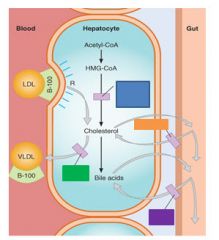
Name the drug class under the boxes:
|

|
|
|
Secondary causes of lipid disorders:
|
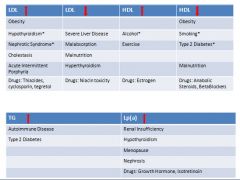
|
|
|
Highlites in the formation of a clot:
|
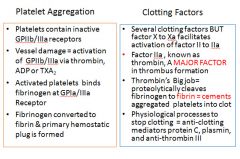
|
|
|
Review of platelet aggregation:
|
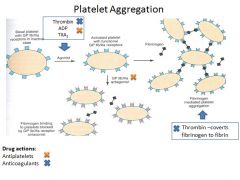
|
|
|
Aspirin:
|
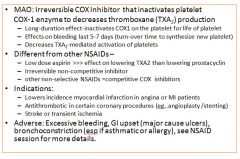
|
|
|
Other antiplatelet agents:
|
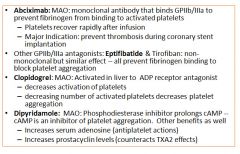
|
|
|
Heparin:
|
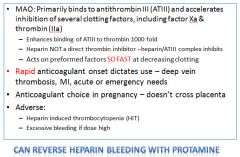
|
|
|
Lepirudin:
|
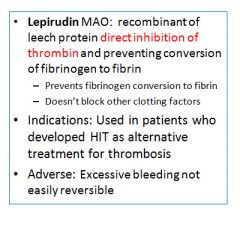
Dabigatran: newly approved oral direct thrombin inhibitor
|
|
|
Warfarin:
|
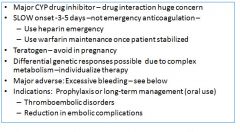
MAO: Competitively inhibits vitamin K epoxide reductase (VKOR) to decrease regeneration of vitamin K supply necessary for these clotting factors
Vitamin K necessary co-enzyme in activating clotting factors Reduces activation of factors II, VII, IX |
|
|
What is the anticoagulant of choice in pregnancy?
|
Heparin
|
|
|
Clot Busters:
|
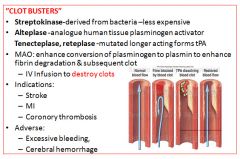
- Streptokinase-less expensive but:
severe allergic rxn in some people. recommended to have corticosteroids available to trt such rxn. - Alteplase, tenecteplase, reteplase: Severe bleeding possible, esp with longer-acting. Reverse excessive bleeding with aminocaproic acid |
|
|
Clinical indications for anticoagulant drugs:
|
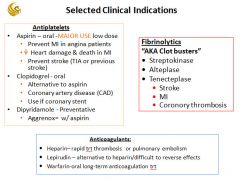
Aggrenox is aspirin + dipyridamole
|
|
|
Review of Autonomic (sympathetic and parasympathetic) Nervous System:
|
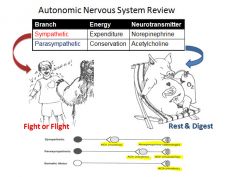
|
|
|
Basic review of autonomic receptors:
|
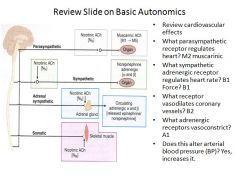
Which receptors increase coronary blood flow? B2 adrenergic receptors
During a stress response, which transmitter exerts the greatest stimulatory effects on B2 adrenergic receptors? Epinephrine |
|
|
More autonomic review:
|
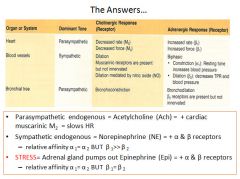
|
|
|
Review of receptors and second messengers:
|
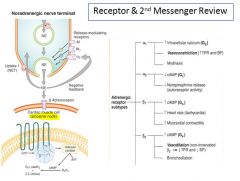
|
|
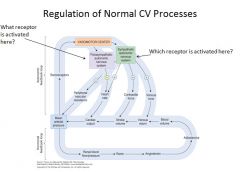
|

*Arterial pressure is a function of cardiac output and peripheral vascular resistance
|
|
|
Baroreceptor reflex to increased BP:
|
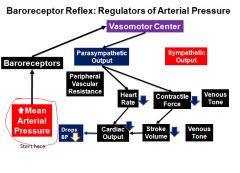
|
|
|
Baroreceptor reflex to low BP:
|
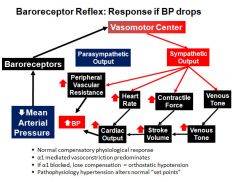
|
|
|
Overview of sympathomimetic agents:
|
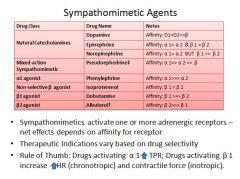
|
|
|
Effects of NE vs Isoproterenol:
|
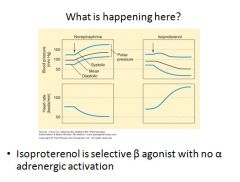
Why would NE decrease the heart rate? Compensatory baroreceptor effect.
So…isoproterenol does the opposite – it decreases blood pressure so to compensate the heart beats faster. What best explains why ISO produces a drop in blood pressure while producing an increase in HR? Vasodilation via B2 without vasoconstriction via A1 activation. |
|
|
Epinephrine:
|
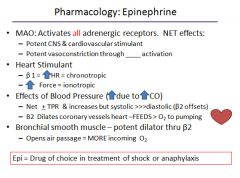
|
|
|
Epinephrine Part 2:
|
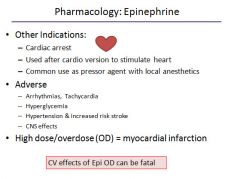
Epi increases renin release and activates the renin-angiotensin-aldosterone system through activation of which receptor? B1
Adenyl cyclase and cAMP 2nd messenger system is activated and renin levels are elevated |
|
|
Norepinephrine:
|
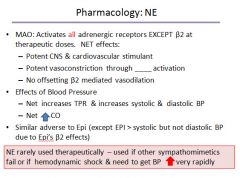
|
|
|
Dopamine:
|
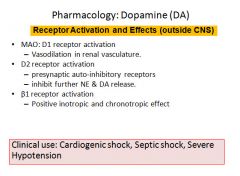
α1 effect : Seen only at very high doses = vasoconstriction.
|
|
|
Alpha agonists:
|
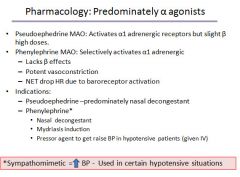
*Note: FYI: Selective uses of selective α1 agonists = tend to decrease HR via baroreceptor effect –use of phenylephrine could be a concern in situations where one needs to get BP up but also needs to get the heart pumping (eg…hypovolemic shock after massive blood loss).
|
|
|
Beta agonists:
|
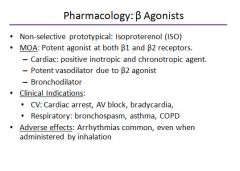
|
|
|
Selective Beta agonist:
|

|
|
|
Summary of receptors involved in heart rate and vessel tone:
|
α1 =vasoconstrictor increases TPR
α2 offsets = auto-inhibition β1 receptor activation = inotropic & chronotropic β2 receptor activation vasodilates coronory vessels (FEEDs the heart O2)/ offsetting vasodilation LAST NOT LEAST = baroreceptor to keep it all in line….if compensatory systems get “reset” get…hypertension/disease |
|
|
Overview of MOA of Beta Blockers:
|
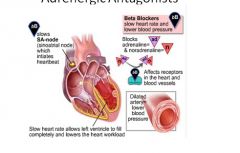
|
|
|
Treatment plans for stage I and II hypertension:
|
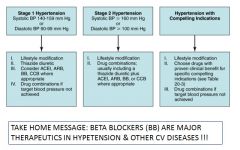
|
|
|
Blocking the a2 receptor decreases release of what neurotransmitter?
|
Norepinephrine
|
|
|
Hypertension Drugs and thier sites of action:
|
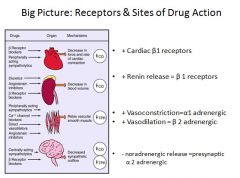
|
|
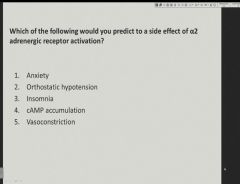
|
Orthostatic hypotension
|
|
|
Pharmacology of Alpha 2 agonists part 1:
|

Practical issues – Per Dr. Asmar, these patients are always trying to drink something (some may overdo it on the volume injested . Dry mouth can a problematic side effect for many patients.
|
|
|
Compensatory response to anti-hypertensive medication:
|
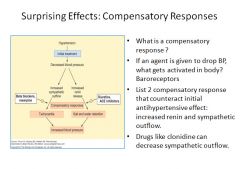
|
|
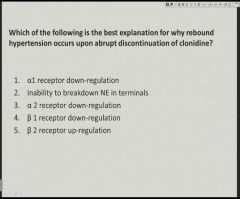
|
alpha-2 receptor downregulation
|
|
|
Trimethapan and Reserpine:
|
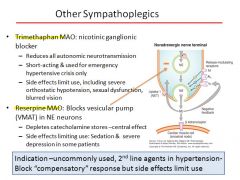
|
|
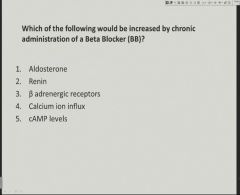
|
B-adrenergic receptors
|
|
|
Overview of alpha blockers:
|

|
|
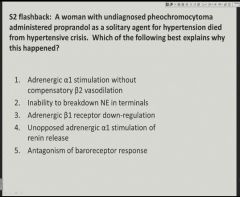
|
Adrenergic A1 stimulation without compensatory B2 vasodilation
|
|
|
Overview of beta blockers:
|

|
|
|
Propranolol:
|
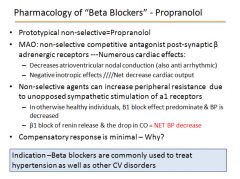
|
|
|
Propranolol Part 2:
|
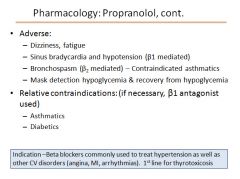
|
|
|
Beta 1 selective antagonists:
|
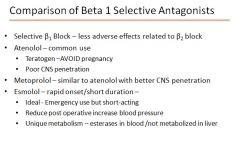
|
|
|
Mixed Alpha antagonist Beta agonists:
|
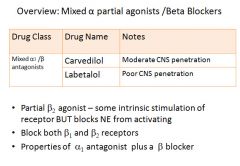
Why choose these over other beta blockers???
- Beta block/partial β agonist sympathomimetic activity (labetalol): Beneficial to certain patients with compromised cardiac function – less negative inotropic / chronotropic effects. - Less effect on airway resistance Less block of coronary vessels (if CAD) Still relative contraindication in asthma - Possess adverse effects of α1 antagonism |
|
|
What is the initial treatment recommendation for hypertension?
|
Thiazide-type diuretics should be initial drug therapy for most, either alone or combined with other drug classes
If BP is >20/10 mmHg above goal, initiate therapy with two agents, one usually should be a thiazide-type diuretic. |
|
|
MOA of thiazide diuretics:
|
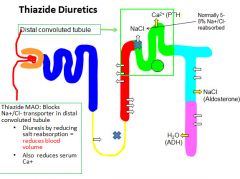
|
|
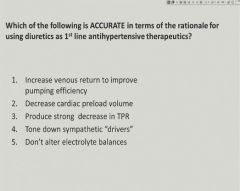
|
Decrease cardiac preload volume
|
|
|
Thiazides:
|
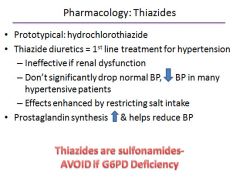
|
|
|
Adverse effects of thiazide diuretics:
|
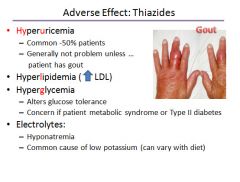
Notes:
Friendly mnemonic for thiazide adverse if you like it: Thia=“Hy UGLi” (hyperUricemia, Glycemia, Lipidemia) Differential effects on potassium – if patients eat too much salt (common in this country), see thiazide induced hypokalemia. If patient restricts salt intake, thiazides may not cause hypokalemia |
|
|
MOA of loop diuretics:
|
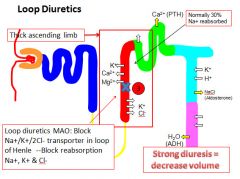
|
|
|
Loop diuretics:
|
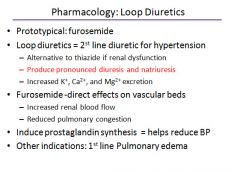
|
|
|
Adverse effects of loop diuretics:
|
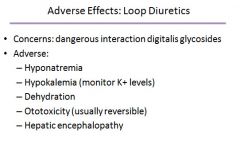
|
|
|
Potassium sparing diuretics:
|
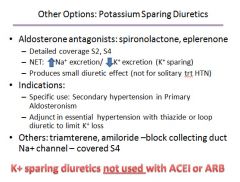
|
|
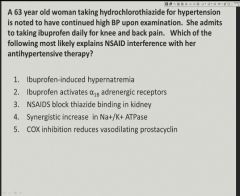
|
COX inhibition reduces vasodilating prostacyclin
|
|
|
MOA of ACE inhibitors:
|
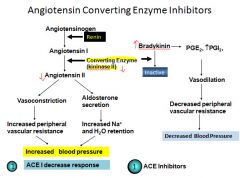
|
|
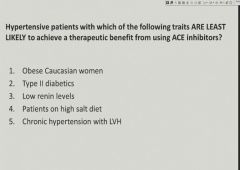
|
Low renin levels
|
|
|
Adverse effects of ACE Inhibitors part 1:
|
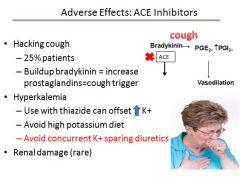
|
|
|
Adverse effects of ACE Inhibitors part 2:
|
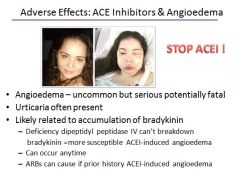
|
|
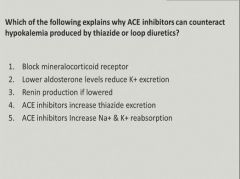
|
Lower aldosterone levels reduce K+ excretion
|
|
|
Angiotensin receptor blockers:
|

|
|
|
Renin Antagonist:
|
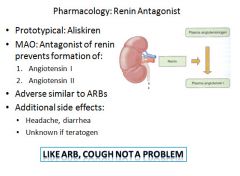
|
|
|
Therapeutic goals of treatment with vasodilators and calcium channel blockers:
|
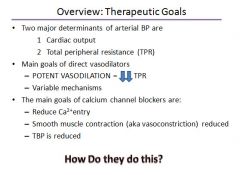
|
|
|
MOA of calcium channel blockers:
|

|
|
|
Bodywide effects of calcium channel blockers:
|
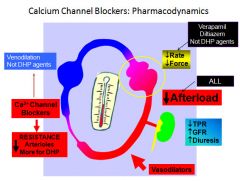
|
|
|
Comparison between effects of CCB and CCB-DHP type on vasculature:
|

|
|
|
Comparison of CCB types:
|
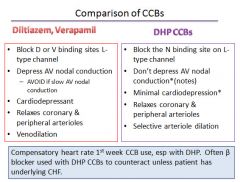
|
|

|
Afterload
|
|
|
Common uses for CCB's:
|
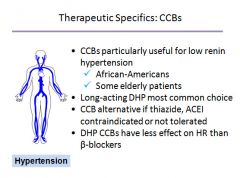
|
|
|
Adverse effects of regular CCB's:
|
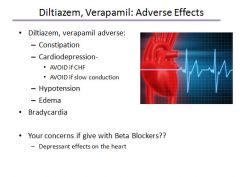
|
|
|
Adverse effects of DHP CCB's:
|

|
|
|
Vasodilators used for severe hypertension:
|
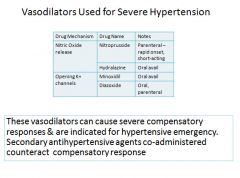
|
|
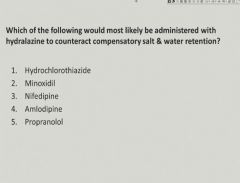
|
Hydrochlorthiazide
|
|
|
Nitroprusside:
|
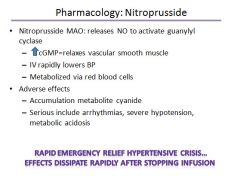
|
|
|
Hydralizine and Minoxidil:
|
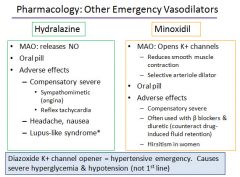
*Hydralazine=lmmunologic reaction more common in slow acetylators = Drug-induced lupus-like syndrome –serious. Detect with positive antinuclear antibody test. Symptoms include arthralgia, serum sickness with fever, vasculitis, hemolytic anemia. Dose-dependent, up to 10% of patients after years hydralazine.
|
|
|
Other indications for vasodilators:
|
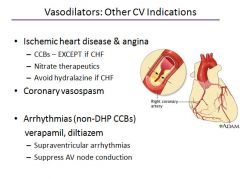
|
|
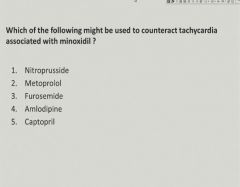
|
Metoprolol
|

